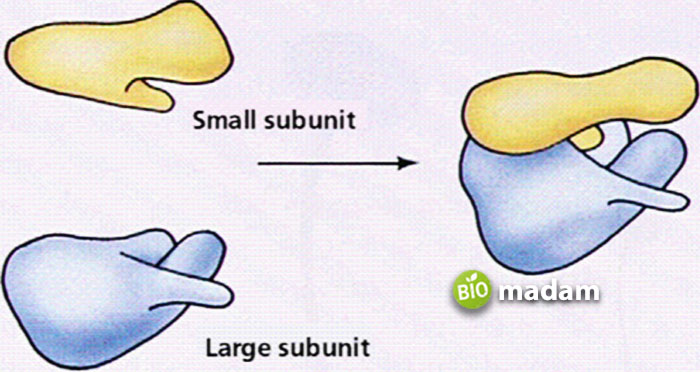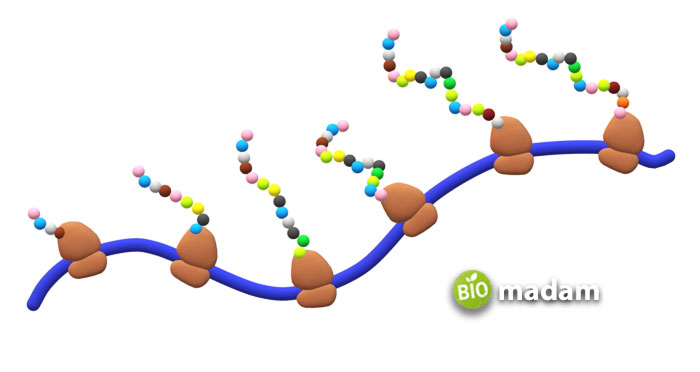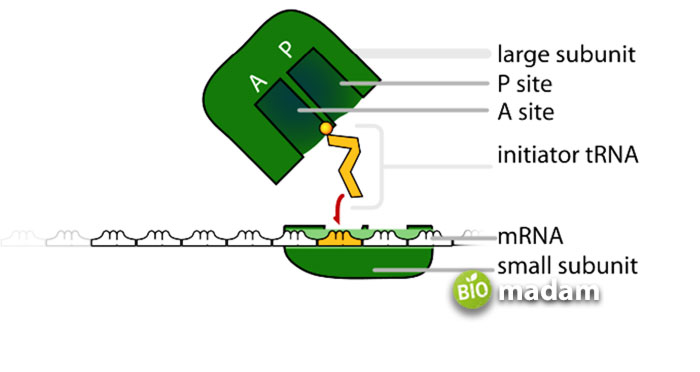Recently updated on March 7th, 2024 at 11:51 am
Every living body has several organelles in its cells that are specialized to perform different functions. One such organelle is the ribosome. It is a complicated structure of molecules that processes to synthesize proteins from amino acids. The entire process is called translation, present in all living organisms.
Proteins are the building units of a body that are essential for human survival. Thus, nature equipped prokaryotes and eukaryotes with this particular structure, and humans further named their ribosomes. Synthesizing protein is the only primary function of ribosomes so we will discuss it in detail.
Let’s first comprehend the structure and subunits of ribosomes.
Structure of Ribosomes

Ribosomes are non-membranous structures existing in all living cells. Moreover, the organelle entirely consists of RNA (ribonucleic acid) and proteins in an equal ratio. Moreover, it has two subunits of different sizes that perform their specific function. The RNA and several types of proteins are linked so that the RNA of one subunit combines with the protein of the other, thus the chain goes on. The larger subunit includes amino acids and binds with the tRNA; on the contrary, the smaller subunit bonds with the mRNA.
When viewed under an electron microscope, ribosomes appear as small, dense particles with a distinctive oblong or slightly elongated shape, resembling a pair of deep bowls or dishes stacked together. Their overall dimensions are approximately 20-30 nanometers in diameter, making them among the largest and most intricate structures in the cell.
Eukaryotic Ribosome
The eukaryotic cells, such as animal and plant cells, have a ribosome of 80S (where S=Svedberg Unit), where its diameter is almost 22 nm. Its large subunit is the 60S containing three rRNA molecules, whereas the small subunit is the 40S with one molecule of rRNA. These subunits together contain about 80 proteins articulated around highly modified ribosomal RNAs (rRNAs).
Prokaryotic Ribosome
On the contrary, a prokaryotic cell has a 70S ribosome with about 20nm diameter & 2.5 x 106 Da molecular weight. Prokaryotic ribosomes constructed of the 50S are composed of a 5S RNA subunit (120 nucleotides), a 23S RNA subunit (2900 nucleotides), and also 31 proteins. Similarly, a 30S subunit has a 16S RNA (consisting of 1540 nucleotides) bound to 21 proteins. A rapidly growing E. coli cell may have as many as 15,000 to 20,000 ribosomes, about 15% of the total cell mass.
What Do Ribosomes Do
Ribosomes are present in two different forms in the cells. They are free-floating in the cytoplasm called free ribosomes or attached to the rough endoplasmic reticulum and nuclear membrane called membrane-bound ribosomes. However, the primary function of ribosomes is protein synthesis. Besides, the location of a ribosome in a cell determines what kind of protein it makes.
Free-floating ribosomes – typically synthesize proteins used inside the cell.
Membrane-bound Ribosomes – are destined for insertion in the plasma membrane or export from the cell.
Cells with high protein synthesis rates, for example, those actively growing, have many ribosomes that make the dense appearance of the cell cytoplasm.
Protein Synthesis – Translation
In other words, we can say that ribosomes help to convert our genetic information into proteins as we move from DNA to RNA and finally to protein. The DNA information encourages us to make proteins, controlling the cell In other words, we can say that ribosomes help to convert our genetic information into proteins as we move from DNA to RNA and finally to protein. The DNA information encourages the making of protein, controlling the cell’s activities.

In transcription, the genetic information in the DNA is copied into a complementary base sequence of RNA. Then the RNA-encoded information is used by the ribosomes to synthesize protein through a specific process called translation.
Components of Translation
The key components helping a translation process are:
- mRNA
- Ribosomes
- tRNA
- Aminoacyl-tRNA synthetase
Types of RNA
The three main types of RNA enhance protein synthesis by encoding the information from the DNA, for example:
- Messenger RNA (mRNA)
- Transfer RNA (tRNA)
- Ribosomal RNA (rRNA)
Messenger RNA (mRNA)
It carries the coded information for making specific proteins from DNA to ribosomes, where proteins are synthesized. Genetic Information on the mRNA is present in Codons (groups of three nucleotides), for example, AUG, GGC, etc. During translation, the cell reads mRNA nucleotide as three base codons, each code for a particular amino acid in the polypeptide.
Transfer RNA (tRNA)
This type of RNA shifts the amino acid to the ribosomes. Transfer RNAs function at the specific site in the ribosomes during the translation process. Furthermore, they read the codons from the mRNA to ensure that the amino acids fit the protein in a unique pattern. One tRNA for each of the 20 amino acids is present that incorporates into proteins to make a polypeptide chain. Thus, the entire procedure requires at least 20 different tRNA molecules.
Ribosomal RNA (rRNA)
Ribosomal RNA forms an integral part of the ribosomes, the cellular machinery for protein synthesis. These RNA molecules direct the catalytic steps of protein synthesis and help amino acids stitch together to make a protein molecule.

The fundamental steps of protein synthesis are:
- Initiation
- Elongation, and
- Termination
Initiation
It is the first stage of protein synthesis where amino acids attach to transfer RNA molecules called the amino acid activation catalyzed by the aminoacyl-tRNA synthetase. The amino acid binds to the 3′-hydroxyl of the terminal adenylic acid on the tRNA by a high-energy bond to initiate the translation process. Moreover, a ribosome has two tRNA binding sites; the P site holds the peptide chain, and the A site accepts the tRNA for the amino acid activation.
Elongation
Here, another aminoacyl-tRNA with an anticodon complementary to the next codon comes to occupy the A site in the presence of GTP. A bond forms between the amino acid and the next aminoacyl tRNA by a peptidyl-transferase enzyme. Then tRNA molecule in the P site becomes uncharged and leaves the ribosome. The ribosome further trans-locates along the mRNA molecule to the next codon; and opens up the A site for the next aminoacyl-tRNA. When the N terminal directs with the C terminal, it forms this polypeptide chain.
Termination
The protein synthesis needs an end step as well, which is the termination step. Here, ribosomes utilize particular stop codons. No tRNA molecule binds to these codons as one of the three stop codons enters the A site. The peptide and tRNA hydrolyze in the P site, releasing the polypeptide into the cytoplasm. The small and large subunits of the ribosome dissociate, ready for the next round of translation, and the process goes on.
What Would Happen Without Ribosomes?
These are the prominent organelles essential to synthesizing proteins in all living cells. The absence of ribosomes can lessen a cell’s functioning, thus reducing its specificity. There would be no life without ribosomes as cells would fail to repair their damage, maintain structure, produce hormones, or pass genetic information.

Jeannie has achieved her Master’s degree in science and technology and is further pursuing a Ph.D. She desires to provide you the validated knowledge about science, technology, and the environment through writing articles.


Great information or breakdown of how this works